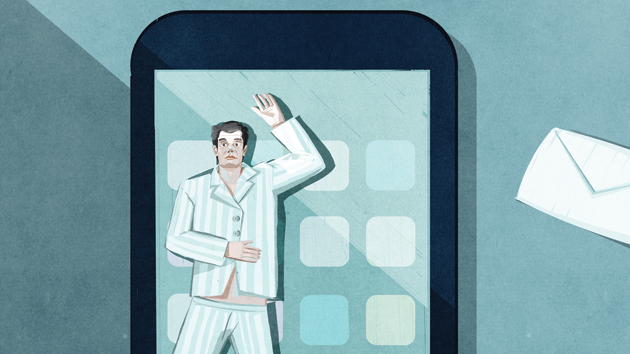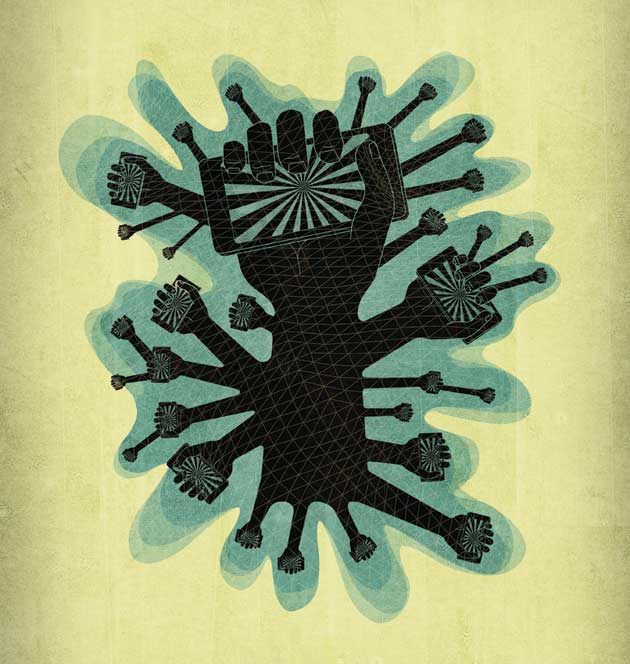
About 15 years ago, anthropologist Claudio Aporta and philosopher Eric Higgs traveled to Igloolik, a remote island in far northeast Canada, to answer an intriguing question: How might newly introduced GPS devices affect the island’s Inuit hunters, who possessed some of the sharpest wayfinding skills on Earth?
You don’t want to get lost on Igloolik. The proximity of magnetic north makes compasses fickle. The land can appear utterly featureless, especially in winter, when the cold—like a cat watching a mouse, “waiting patiently to see if he would make a mistake,” as explorer R.M. Patterson once put it—can make the smallest mishap fatal. During the summer, when Inuit hunters stalk walrus by boat, sea fog can close so tight around a vessel that anyone lacking GPS must drop anchor, lest they run aground, or steer out to sea and risk running out of fuel.
To navigate this murk, Igloolik’s hunters had long attended closely to not just stars and landmarks, but patterns of wind, snowdrift, current, animal behavior, and light. They read as much in the wind’s snow sculptures as Polynesian sailors read in constellations and tides. They had no formal training and rarely used paper maps. Yet the best hunters carried in their heads extraordinarily intricate maps of the landscape, constructed through decades of experience and tutelage. During a break in travel, a veteran hunter might ask novices to describe the location of a place, and nudge his protégés along as they worked out the problem aloud. This was easier when the Inuit traveled by dogsled—no engine noise—but it still happens in the snow-machine age.
Like the snowmobile, GPS offered the hunters irresistible advantages. They could travel more safely through terrestrial whiteouts or ocean fog. If a snowmobile conked out or a hunting party had to stash food or equipment, GPS made it easy to mark the spot and find it later. And the hunters always knew the way home. But within a few short years, as Aporta and Higgs documented, the GPS units revealed some sharp limitations. In winter, the batteries quickly failed unless the devices were kept against the body under much clothing. The units themselves were devilishly hard to operate with gloves or mittens, and their screens iced over in seconds.
Worse, GPS was leading young hunters into mortal danger. Some followed straight-line tracks onto thin ice and fell through. Others, when their devices failed, couldn’t read the snow or recognize traditional landmarks. After several near-fatal and fatal incidents, the villagers created a program to integrate GPS with traditional wayfinding. Knowing the technology was here to stay, the Igloolik Inuit wanted to make sure they could harness its advantages without literally losing their way.
An extreme example? Well, no. We mainlanders are getting into far more trouble with GPS than the Igloolik people ever have. Particularly in the car-addicted, smartphone-besotted United States, the last 15 years have produced a daunting database of disasters wherein people navigating with tiny screens drive directly into danger, destruction, and death.
In Bedford, New York, in 2008, a rental car driver fixated on his GPS unit barely escaped being hit by a train. Other people have driven into lakes and oceans. Countless truckers attending to GPS while ignoring signage have smashed into overpasses or become wedged beneath them—in 2009, the New York State Department of Transportation blamed GPS as a factor in more than 80 percent of such incidents. That same year, a Death Valley tourist followed her GPS down an increasingly remote road until her Jeep got stuck in the sand. She survived the searing heat for a week; her six-year-old son did not. In his book Pinpoint: How GPS Is Changing Technology, Culture, and Our Minds, author Greg Milner relates how, in March 2015, yet another GPS-smitten driver ignored cones, signs, “and other deterrents” warning him away from a closed bridge. His vehicle plunged 40 feet and burst into flames. The man escaped. His wife died. “Something,” Milner writes, “is happening to us.”
We’re becoming navigational idiots. The problem isn’t GPS itself. The Global Positioning System, which uses a constellation of satellites to determine one’s location on the globe, is just a way of fixing points on a map. Rather, the problem is how smartphone apps such as Google Maps, Apple Maps, and Waze display our routes. Because these apps seek primarily to direct us efficiently from A to B, their default presentation is a landscape somewhere between minimalist and impoverished—typically a fat colored line (your route) running through a largely featureless void. Mappers call this goal-oriented perspective” egocentric.” It’s all about you.
Paper maps, by contrast, use an “allocentric” presentation—one that forces you to plan and frame your route within a meaningful context: towns, forts, universities, parks, and natural features named for local heroes and history (such as Lake Champlain and Smugglers’ Notch in my home state of Vermont), distinctive shapes (Camel’s Hump), or local flora and fauna. (The Winooski River, which flows through my town, gets its name from the Abenaki word for the wild onion that grows on its banks.) Such maps bear a rough but essential resemblance to the mental map locals carry in their heads.
Display size allowing, a digital map can also show such context. Google Earth does so beautifully. Even your Google Maps smartphone app will display many details of the surroundings, albeit on a small scale, when you’re not in navigation mode. But enter in a destination and the context vanishes. The landscape is cleansed of distracting features and the map spins so that the top of your phone is not north, but whichever direction you happen to be traveling. You’ve just turned an allocentric world egocentric.
The distinction between these two wayfinding modes interests not just mapmakers, but neuroscientists, for each draws upon a distinctive neural network to understand space and move us through it. Your phone’s default egocentric (or “cue-based”) mode is the domain of the caudate nucleus, a looping, snake-shaped structure that is heavily involved in movement and closely tied to areas of the brain that respond to simple rewards. Navigating by map—often called a cognitive mapping strategy because it builds and draws on the map in your head—primarily uses the hippocampus, an area in the center of the brain crucial to spatial memory, autobiographical memory, and our ability to ponder the future.
While most of us favor one or the other of these navigational strategies, both are required; lose either and you’ll soon lose your way. You enlist the caudate’s cue-based mode, for instance, when your friend Jane tells you to take Exit 8, go left on Route 12, turn right about two miles later at the red church, and hers is the fifth house on the right. With decent directions, the method is idiotproof. But it doesn’t really tie into any deeper mental map.
You’ll fire up your hippocampus, though, if Jane mails you a road map with an X marking her house. You’ll need to understand the map well enough to plot your route, and memorize it well enough to make the drive. Studying a map “is difficult, it’s complicated, it’s demanding,” says Veronique Bohbot, who investigates the neuroscience of navigation at McGill University in Montreal. Yet it’s ultimately more versatile and powerful because it provides a richer framework for social, historical, and practical information. In return for your efforts, it lets you improvise, create shortcuts, and, should you get lost, reorient yourself.
Some years ago, Matt Wilson and another scientist at the University of Arizona discovered that by wiring up special neurons, called place cells, in a rat’s hippocampus, they could observe how the animal builds a mental map as it navigates a maze.
As the rat learns a desired route (ending with a treat), some of its place cells begin firing at recognized locations—landmarks or intersections where it needs to turn. After the rat completes a route, Wilson discovered, its place cells replay the route backward, and later forward again—this process continues in the rodent’s dreams as it consolidates the memories of its daily explorations. After mastering several routes in a maze—home to point A, home to point B, home to point C—the rat can improvise routes from C to A or A to B without returning to the start. Bingo: a cognitive map.
We humans appear to do something similar. Say you travel to an unfamiliar city but forget your smartphone. The first night, the hotel clerk gives you directions to a restaurant with a sinfully rich chocolate mousse. The next day, she points you to a park by the river. On the third, to a museum. Each day, absorbing visual cues and landmarks, you develop and refine a sense of geography and direction. On the fourth day, your love interest arrives. You walk to the museum, and when the two of you emerge, ravenous, you realize that if you cut over a block and walk north a few more, you should find the river, and then, walking east-ish between river and park, that wonderful restaurant. “The one with the sinful mousse?” your companion inquires, eyebrow raised. You nod. Bingo: a cognitive map with benefits.
Now think. Had you relied on Google Maps instead, you’d have absorbed less of the terrain, built a lame cognitive map, gotten lost when your battery died, missed the restaurant, and left your partner parched and peckish.
Small potatoes, maybe—but they get bigger. Bohbot, the McGill researcher, believes that by leaning too heavily on smartphone navigation, we may actually be altering the physiology of our brains.*
How so? For starters, notes University of Pennsylvania neuroscientist Russell Epstein, a leading spatial cognition researcher, we know that followers of cue-based routes have more active caudates than mappers do. We also know that the volume of gray matter in the hippocampi of English cabbies increases as they memorize the streets of central London—a.k.a. “the knowledge”—a longtime requirement for a taxi license.
This raises a question: Might overreliance on our phone apps’ egocentric navigational systems atrophy the hippocampus? Based on limited animal studies and her ongoing work in humans, Bohbot suspects so. And this concerns her, because people with smaller hippocampi stand at greater risk of memory loss, Alzheimer’s, dementia, depression, schizophrenia, and post-traumatic stress disorder. And, of course, getting lost.
So even if you don’t hunt walrus or do much backwoods hiking, it makes sense to protect your ability to wayfind. To that end, I offer a tactic and a strategy. The tactic: Bring back North. You can redirect most smartphone navigation apps to align with the magnetic compass instead of your direction of travel. Doing so forces you to orient yourself to the real world, rather than indulge in the egocentric convenience of having it spin beneath you every time you turn.
The broader strategy comes from Yale historian Bill Rankin, whose book, After the Map, charts the rise of GPS. Rankin says he finds it helpful to distinguish between “coordination” (just get me there), for which a simple route suffices, and “familiarity,” for which a cognitive map serves best.
Coordination, Rankin notes, is why the military developed global positioning to begin with: It’s just the thing when you want to put a cruise missile into a bunker or supplies into a storm-struck village. But truly knowing a place means mastering its landscape, and for that you need a cognitive map. As an undergrad in Houston, Rankin began marking his favorite jogging routes on a paper map pinned on his wall. He stayed in shape and learned the town in the process. Know why you’re traveling, he advises, and choose your navigation mode accordingly.
*Clarification: This story, which was originally published in our November/December 2016 print issue, was revised to more accurately reflect Bohbot’s findings.
















